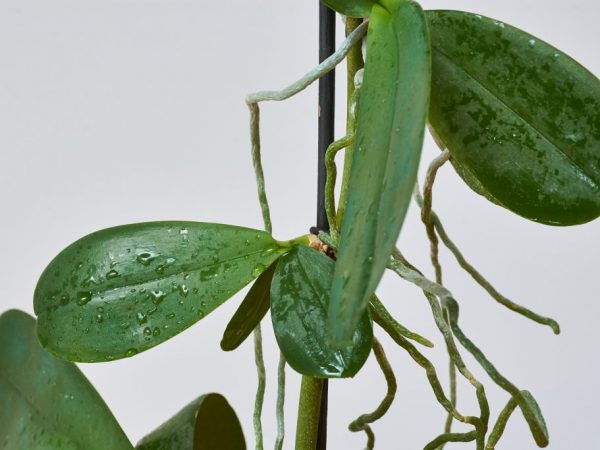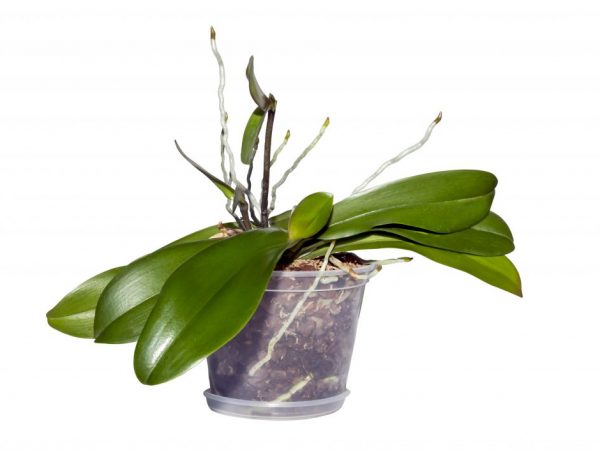Problems with the reproduction of orchids
When breeding flowers at home, it is important to observe all the nuances. Orchid is a special exotic flower. If the orchid has no children, you need to know how to get a new young plant.

Problems with the reproduction of orchids
Breeding methods for orchids
Orchids, or phalaenopsis, grow well and produce many flowers when properly cared for. If the conditions are met, then they are easy to breed with the help of children.
There are several breeding methods:
- bottle seedlings (flask);
- division;
- cuttings;
- basal processes;
- peduncle buds.
Sprouts appear in different places on the mother's trunk: at the base of the root collar, from a dormant bud, after flowering has passed.
Reasons for the absence of children
The mother plant does not always sprout. The reasons are different, they include the following:
- long peduncle;
- bad light;
- low room temperature.
If the sprout has appeared in the root zone, then no intervention from the outside is required. It must be watered, provided with lighting and the required temperature.
If a baby is needed on a peduncle, then it is important to hold several events. After the main flowering has passed, the peduncle stem is shortened, leaving 2 cm above the bud.
Good lighting can be provided artificially by placing an electric lamp next to it. The abundance of light will awaken the kidney.
The baby will appear faster if the temperature in the room is at least 27 ° C. In such conditions, the peduncle will not be able to develop, and the bud will feel comfortable.
The process of the appearance of children can take up to six months.
It will become viable when at least 2 roots appear. To speed up the development of the orchid, it is stimulated with hormonal paste. To do this, cut off the top on the sleeping kidney and cover it with paste. Leave alone in a warm and humid room. Soon she will wake up and give a baby.
Features of development and care
The new shoots are tender and capricious. Caring for them is different from caring for the mother plant.
Root baby care
If a basal baby (basal) appears, this serves as a signal that changes should be made in the content of the orchid, because the young plant is completely dependent on the mother and receives all the necessary substances through her. It is worth monitoring the condition of the maternal roots and nutrition.
The roots should remain green after watering and silvery when dry. The mother leaves should be firm, firm and free from damage. A good shoot will appear on a quality stem.
It is difficult to separate the 2 parts, because they have one root system. One of the parts is easily damaged, so they are often not separated. Usually they wait until the mother plant dries up completely, then the new bud begins to bloom.
Stem baby care

On the mother's flower, the roots of the baby will quickly grow
The stem baby must meet the following parameters:
- roots up to 5 cm;
- at least 3-4 sheets up to 6 cm in size;
- beautiful green leaves.
The main thing is the presence of roots. The process of their growth in soil or moss is lengthy, but they quickly grow on the mother flower.
Depositing rules
Transplanting affects the health of the flower and its productivity, therefore, the following rules are observed:
- Carefully detach from the base.
- Together with the peduncle, the bud is cut off 0.5 cm above the growth point. Then it dries up. It will take 10-12 hours.
- A pot of 10 cm in diameter is being prepared. Fine drainage (expanded clay and bark) is poured into it. A process is installed in the center. A piece of Styrofoam is placed under its neck and sprinkled with bark on top until the pot is full.
- You cannot water immediately. The first time this is done after 5 days.
Planting will be successful if the roots have reached the desired length. But even if you follow all the rules, young plants will bloom only after 4-5 years. Fertilizers should be applied one month after planting.
Diseases and prevention
Orchids get sick sometimes. Disease is caused by overprotectiveness.
Infectious diseases slow down the growth of the flower, the leaves wither, sometimes burns are visible.
Frequent watering leads to decay of the roots, and poor lighting leads to stretching of the stem and underdevelopment of buds.
Direct sunlight causes yellowing of the leaves. Other reasons:
- Viral diseases are manifested by spots on the leaves. It is better not to treat such plants, but to burn them so that the rest do not get infected. Sometimes it is worth cutting off the damaged foliage and doing cauterization with iodine at the cut points.
- Anthracosis is manifested by blackening on the leaves. It is caused by a poorly ventilated room and high humidity. Leaves with spots are cut off and discarded, the cuts are cauterized.
- Powdery mildew appears as a purple-white bloom on the surface. The disease is dangerous and requires urgent treatment. The reason for its occurrence is high humidity and temperature. For prevention and treatment, sprinkle with phytosporin or a solution of colloidal sulfur.
Conclusion
Growing orchids at home is fun. If you follow the rules of care, then there will be no problems. Flowers are striking in their variety and incredible beauty. Phalaenopsits bloom for a long time.

